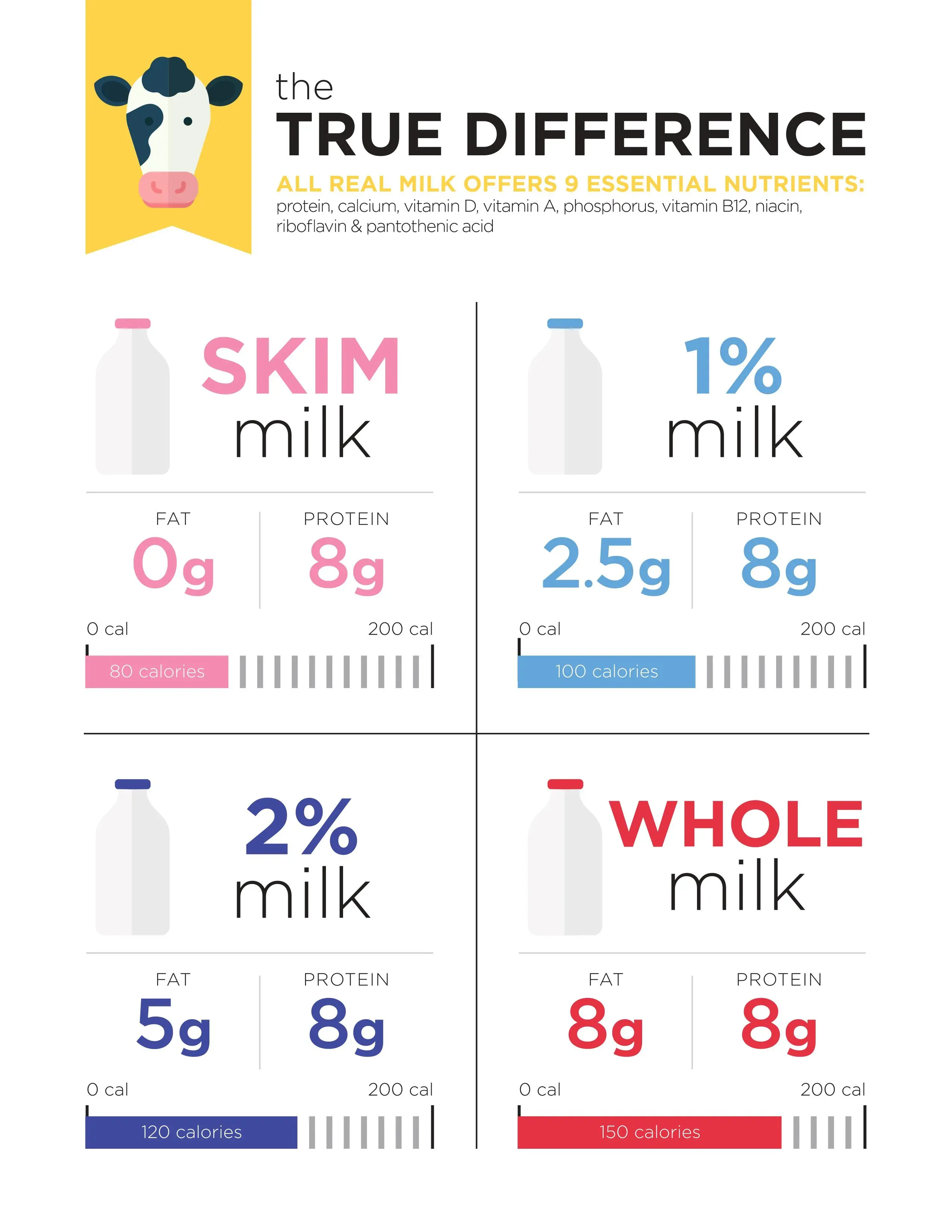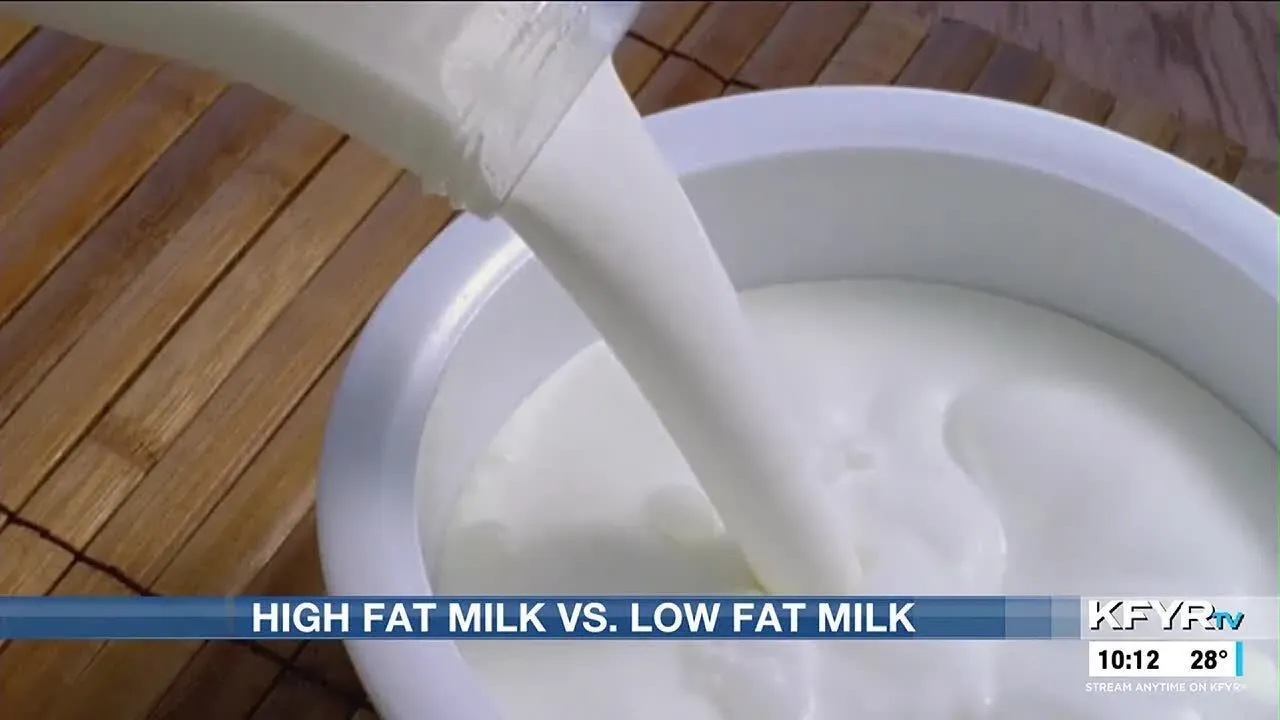Table of Contents
For decades, we were told to ditch the whole milk and grab the skim. It was simple advice: fat is bad, especially saturated fat, and milk has fat. Therefore, low fat vs high fat milk wasn't much of a contest; low fat won. Case closed, right? Not so fast. Turns out, the science on dietary fat is a bit more nuanced than a simple "fat is bad" mantra. The difference between whole milk, 2%, 1%, and skim isn't just about texture or how it froths in your coffee; it's about how these fat levels might actually impact your health. We're talking about more than just calories here. We'll dive into what actually separates these milk types nutritionally, challenge some old assumptions about saturated fat and heart health, look at surprising links between full-fat dairy and things like weight management and diabetes risk, and ultimately, help you navigate the low fat vs high fat milk aisle without needing a science degree. Get ready to question everything your school health class taught you.
Nutritional Snapshot: Beyond Just the Fat

Nutritional Snapshot: Beyond Just the Fat
The Obvious: Fat Content Varies Wildly
Look, the most glaring difference when you line up a carton of whole milk next to a carton of skim is the fat. Whole milk typically clocks in around 3.25% milk fat. Move to reduced-fat, often labeled 2%, and you're down to, well, 2%. Low-fat (1%) cuts it back further. Skim milk aims for less than 0.5% fat, essentially stripping out most of it. This isn't rocket science; the names pretty much give it away. But focusing only on this number misses a larger picture of what's actually in your glass. It's like judging a book solely by its cover thickness.
The Not-So-Obvious: Micronutrient Consistency
Here's where the "beyond just the fat" part of the nutritional snapshot comes into play. Despite the drastic differences in fat and calorie counts, these milk varieties are surprisingly similar in their micronutrient punch. We're talking calcium, that bone-building champ everyone associates with milk. Vitamin D, often added to help you absorb that calcium. Phosphorus, potassium, B vitamins like riboflavin and B12 – these essential nutrients are present in pretty much the same amounts whether you're drinking full-fat or fat-free. Your body gets a solid dose of these regardless of which carton you grab.
So, while the energy density changes, the foundational vitamin and mineral profile remains remarkably stable. It’s a key point often lost in the fat-centric discussion.
Nutrient (Approx. per cup) | Whole Milk (3.25% fat) | 2% Milk (Reduced Fat) | Skim Milk (Fat-Free) |
|---|---|---|---|
Protein (g) | 8 | 8 | 8 |
Calcium (mg) | 300 | 300 | 300 |
Vitamin D (IU) | 100 (fortified) | 100 (fortified) | 100 (fortified) |
Vitamin B12 (mcg) | 1.2 | 1.2 | 1.2 |
Other Bits and Pieces: Vitamins and Fatty Acids
Now, let's talk about those fat-soluble vitamins – A, D, E, and K. Since vitamins A and D are often added back into milk after processing (fortification), you'll find similar levels across types, regardless of natural fat content. However, some naturally occurring fat-soluble nutrients and beneficial fatty acids present in whole milk are significantly reduced or absent in lower-fat versions. This includes conjugated linoleic acid (CLA) and omega-3 fatty acids, though the amounts aren't huge sources compared to, say, fatty fish. Still, they're part of the whole milk package that gets removed when you strip out the fat. This adds another layer to the low fat vs high fat milk debate beyond simple calorie counting.
Low Fat vs High Fat Milk: The Saturated Fat Question

Low Fat vs High Fat Milk: The Saturated Fat Question
The Old Guard: Saturated Fat as Public Enemy Number One
For years, dietary guidelines hammered home one message: saturated fat was bad news for your heart. It was linked to higher cholesterol, blocked arteries, the whole nine yards. Milk, especially whole milk, has a decent amount of saturated fat. So, the logic was simple: cut out the fat, cut out the risk. This led to the big push for low-fat and skim milk, putting low fat vs high fat milk squarely in the "healthier vs. less healthy" box based almost entirely on this one nutrient. It felt like common sense at the time, a clear path to better health by avoiding the greasy stuff.
Challenging the Conventional Wisdom
But science rarely stays settled for long. Over the past decade or so, researchers have started taking a closer look at saturated fat, and specifically, the saturated fat found in dairy. Turns out, it might not be the one-dimensional villain we painted it to be. Large studies tracking people over many years haven't always shown the strong link between full-fat dairy consumption and heart disease that the old guidelines predicted. Some studies even suggest a neutral, or in some cases, potentially beneficial effect. It's enough to make you wonder if we threw the baby out with the bathwater when we universally demonized full-fat milk.
Consider these shifting perspectives:
- **Old View:** Saturated fat from dairy directly increases LDL ("bad") cholesterol and heart disease risk.
- **Newer View:** The effect of saturated fat depends on the food source; the "matrix" of dairy might mitigate negative effects.
- **Emerging Data:** Some studies link full-fat dairy to lower risk of certain conditions.
The Nuance: Not All Saturated Fat Acts the Same
So, what's going on? Why might dairy fat be different? Part of it comes down to the structure of milk itself – the mix of fat, protein, calcium, and other compounds. This "food matrix" might influence how saturated fat is processed by the body. There's also evidence suggesting that saturated fat from dairy can actually increase levels of HDL (the "good" cholesterol) and might change LDL particles to be larger and less harmful. It's not a free pass to guzzle whole milk non-stop, but it definitely complicates the simple "low fat vs high fat milk because saturated fat is bad" argument we've heard for years. The conversation is evolving beyond just a single nutrient count.
Weight, Diabetes, and High Fat Dairy: What the Research Shows

Weight, Diabetes, and High Fat Dairy: What the Research Shows
Flipping the Script on Weight Gain
so we've poked holes in the saturated fat panic. Now let's tackle something even more counter-intuitive: the idea that eating fat makes you fat. For ages, the standard advice for managing weight was simple: cut calories, especially from fat. This fed directly into the low fat vs high fat milk debate, pushing people towards skim to save those precious calories. Yet, when scientists started looking at large populations and their actual eating habits over time, a weird pattern emerged. People who consumed full-fat dairy products didn't necessarily gain more weight or have a higher risk of obesity compared to those who stuck to low-fat versions. In fact, some studies hinted at the opposite – a link between higher full-fat dairy intake and a lower risk of becoming overweight or obese. It's enough to make you scratch your head and wonder if the calorie-counting approach missed something fundamental about how different foods affect our bodies.
Dairy Fat and Metabolic Health
Beyond just the number on the scale, the research gets even more interesting when you look at metabolic health. We're talking about conditions like metabolic syndrome and type 2 diabetes. These are major health concerns, and conventional wisdom again pointed the finger at dietary fat, particularly saturated fat, as a culprit. But similar to the weight findings, studies examining dairy fat consumption and the risk of these metabolic issues have delivered surprising results. Several observational studies have found that people who regularly consume full-fat dairy have a *lower* risk of developing type 2 diabetes and metabolic syndrome compared to those who consume less or opt for low-fat dairy. This doesn't mean chugging a gallon of whole milk is a magic bullet, but it certainly challenges the long-held belief that fat-free is always the healthier choice for managing these conditions.
What might explain this? It could be the specific fatty acids in milk fat, the interaction of fat with other dairy components like protein and calcium, or maybe full-fat dairy is simply more satisfying, leading people to eat less overall. The exact mechanisms are still being figured out, but the observational data is consistently raising questions about the low fat vs high fat milk narrative we've been sold for decades.
Consider these findings:
- Some studies link full-fat dairy intake to reduced risk of obesity.
- Higher consumption of full-fat dairy is associated with a lower risk of type 2 diabetes in several populations.
- The "food matrix" of dairy might play a role in its metabolic effects.
Beyond Association: What About Cause?
It's crucial to remember that many of these findings come from observational studies. They show associations, not necessarily direct cause and effect. People who choose full-fat dairy might have other lifestyle habits that contribute to better metabolic health, like exercising more or eating fewer sugary foods. Researchers try to account for these factors, but it's tough to isolate dairy fat completely. However, the consistency of the findings across different studies and populations makes them hard to ignore. It suggests there's more to the story than just calories and saturated fat percentages when comparing low fat vs high fat milk.
Picking Your Pour: Deciding on Low Fat vs High Fat Milk

Picking Your Pour: Deciding on Low Fat vs High Fat Milk
Picking Your Pour: Deciding on Low Fat vs High Fat Milk
Alright, so we've pulled back the curtain on the low fat vs high fat milk saga. We know skim isn't inherently superior just because it lacks fat, and whole milk isn't the dietary demon it was made out to be. So, standing in the dairy aisle, staring at the options, how do you actually choose? It boils down to a few things, and honestly, it's less about following outdated dogma and more about your own body, your goals, and what you actually enjoy drinking. If you're strictly counting calories for a specific reason and every single one matters, sure, skim saves you a few. But if you find whole milk more satisfying, maybe that means you're less likely to snack on something else later, potentially balancing out the calorie difference. Consider your overall diet – are you getting healthy fats elsewhere? Do you need the potential benefits tied to the fat matrix in whole milk, like improved satiety or links to metabolic health? Or maybe you just hate the watery texture of skim and prefer something creamier. There's no universal "right" answer here; the best low fat vs high fat milk choice is the one that fits your individual needs and preferences, backed by the latest understanding of the science, not the headlines from 1995.
Making Your Milk Choice: Beyond the Old Rules
So, we've taken a look under the hood of the whole fat versus low fat milk debate. It's clear the black-and-white picture painted years ago, where fat was the villain, has faded into something far more complex. The difference isn't just calorie counts; it involves how different fat levels might interact with your body, potentially influencing everything from cholesterol markers to your risk of developing conditions like type 2 diabetes. While skim and low-fat milk remain perfectly valid options, especially for those managing strict calorie goals, the notion that full-fat dairy is inherently detrimental seems less supported by current research. The best milk for you isn't a universal decree, but rather a decision informed by your overall diet, health goals, and perhaps a chat with someone who knows your specific situation. The dairy aisle just got a little more interesting, didn't it?
